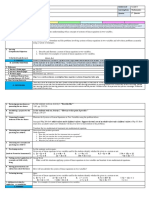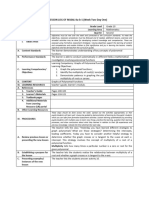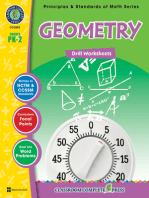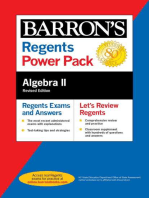Week3 (June)
Week3 (June)
Uploaded by
Amilou Aganan NepomucenoCopyright:
Available Formats
Week3 (June)
Week3 (June)
Uploaded by
Amilou Aganan NepomucenoOriginal Description:
Original Title
Copyright
Available Formats
Share this document
Did you find this document useful?
Is this content inappropriate?
Copyright:
Available Formats
Week3 (June)
Week3 (June)
Uploaded by
Amilou Aganan NepomucenoCopyright:
Available Formats
School Poctoy National High School Grade Level 8
DAILY LESSON LOG Teacher Ms. Amelyn S. Olores Learning Area Mathematics
Teaching Date June 19, 2017 Quarter 1st
and Time 1:00- 2:00/ 2:00- 3:00
I. OBJECTIVES
A. Content Standard The learner demonstrates understanding of key concepts of factors of
polynomials, rational algebraic expressions, linear equations and inequalities in
two variables, systems of linear equations and inequalities in two variables and
linear functions.
B. Performance Standard The learner is able to formulate real-life problems involving factors of
polynomials, rational algebraic expressions, linear equations and inequalities in
two variables, systems of linear equations and inequalities in two variables and
linear functions, and solve these problems accurately using a variety of
strategies.
C. Learning M8AL-Ia-b-1
Competencies/ The learner factors completely different types of polynomials (polynomials with
Objectives common monomial factor, difference of two squares, sum and difference of two
cubes, perfect square trinomials, and general trinomials).
II. CONTENT Factoring the Sum and Difference of Two Cubes
III. LEARNING RESOURCES
A. Reference Elementary Algebra I pp. 189-190
Next Century Mathematics, The New Grade 8, pp. 62- 65
B. Other Learning
Resources
IV. PROCEDURES
A. Reviewing the previous Recall the process of factoring Quadratic Trinomials and the pattern of the
lesson or presenting special products.
the new lesson
B. Establishing a purpose The students should know the process of factoring the sum and difference of
for the lesson two cubes.
C. Presenting Present the steps in factoring the sum and difference of two cubes on page 63.
examples/instances of
the new lesson
D. Discussing new The students will study the illustrative examples A and B on page 189.
concepts and practicing They will try to explain the process of factoring the sum and difference of two
new skills # 1 cubes.
E. Discussing new The students will discuss in pair how the illustrative example C has been
concepts and practicing factored out.
new skills # 2
F. Developing mastery Using the steps given, let the students try to get the factor of the following
(Leads to Formative expressions:
Assessment 3) 1. 𝑦 3 − 27
2. 𝑥 3 − 8𝑦 3
G. Finding practical Group the students into five and let them find the factor of the following
applications of expressions:
concepts and skills in 1. 125𝑢3 − 𝑣 3
daily living 2. 64 − 𝑤 3
3. 8𝑤 3 − 𝑥12
H. Making generalizations Ask: How can you get the factor of the sum and difference of two cubes?
and abstractions about
the lesson
I. Evaluating learning Factor the following completely.
1. 𝑎3 − 8𝑐 3
2. 216𝑐 3 − 1
3. 𝑢6 + 𝑣 12
4. 𝑡 6 − 1
5. ℎ6 − 𝑗 12
J. Additional activities for Factor the expressions 21- 25 on page 188.
application or
remediation
V. REMARKS
VI. REFLECTION
A. No. of learners who
earned 80% in the
evaluation
B. No. of learners who
required additional activities
for remediation
C. Did the remedial lessons
work?
D. No. of learners who
continue to require
remediation
E. Which of my teaching
strategies work well? Why
did this work?
F. What difficulties did I
encounter which my
principal or supervisor can
help me solve?
G. What innovation or
localized materials did I
used/discover which I wish
to share with other teachers?
School Poctoy National High School Grade Level 8
DAILY LESSON LOG Teacher Ms. Amelyn S. Olores Learning Area Mathematics
Teaching Date June 20, 2017 Quarter 1st
and Time 1:00- 2:00/ 2:00- 3:00
I. OBJECTIVES
A. Content Standard The learner demonstrates understanding of key concepts of factors of
polynomials, rational algebraic expressions, linear equations and inequalities in
two variables, systems of linear equations and inequalities in two variables and
linear functions.
B. Performance Standard The learner is able to formulate real-life problems involving factors of
polynomials, rational algebraic expressions, linear equations and inequalities in
two variables, systems of linear equations and inequalities in two variables and
linear functions, and solve these problems accurately using a variety of
strategies.
C. Learning M8AL-Ia-b-1
Competencies/ The learner factors completely different types of polynomials (polynomials with
Objectives common monomial factor, difference of two squares, sum and difference of two
cubes, perfect square trinomials, and general trinomials).
II. CONTENT Factoring by Grouping
III. LEARNING RESOURCES
A. Reference Elementary Algebra I pp. 190- 191
B. Other Learning Mathematics Learners Module, pp 44-46
Resources
IV. PROCEDURES
A. Reviewing the previous Recall the process of factoring sum and difference of two cubes and the
lesson or presenting Properties of Equality (Commutative and Associative Properties)
the new lesson
B. Establishing a purpose The students should know the process of factoring polynomials by grouping.
for the lesson
C. Presenting Present the steps in factoring polynomials by grouping on page 44 on LM.
examples/instances of
the new lesson
D. Discussing new The students will study the illustrative example on page 44 and explain the
concepts and practicing process.
new skills # 1
E. Discussing new The students will discuss in pair how the polynomial 18𝑙𝑣 + 6𝑙𝑒 + 24𝑜𝑣 + 8𝑜𝑒
concepts and practicing has been factored on page 45.
new skills # 2
F. Developing mastery Using the steps given, let the students try to get the factor of the following
(Leads to Formative expressions:
Assessment 3) 1. 4𝑤𝑡 + 2𝑤ℎ + 6𝑖𝑡 + 3𝑖ℎ
2. 15𝑡𝑒 − 12ℎ𝑒 + 10𝑡𝑦 − 8ℎ𝑦
G. Finding practical Group the students into five and let them find the factor of the following
applications of expressions:
concepts and skills in 1. ℎ𝑣 − 12ℎ𝑒 + 10𝑡𝑦 − 8ℎ𝑦
daily living 2. 10𝑡𝑖 − 8𝑡𝑠 − 15ℎ𝑖 + 12ℎ𝑠
3. 88𝑓𝑜 + 16𝑟𝑜 − 99𝑓𝑚 − 18𝑟𝑚
H. Making generalizations Ask: How can you get the factor polynomial by grouping?
and abstractions about
the lesson
I. Evaluating learning Factor the following completely.
1. 7𝑠 + 35𝑜𝑚 + 9𝑠𝑒 + 45𝑜𝑒
2. 42𝑤𝑎 + 54𝑤𝑡 + 56ℎ𝑎 + 72ℎ𝑡
3. 36𝑦𝑢 − 24𝑟𝑜 + 12𝑜𝑢 − 72𝑦𝑟
4. 72ℎ𝑒 + 16𝑤𝑒 + 27ℎ𝑛 + 6𝑤ℎ
5. 26𝑤𝑟 − 91𝑜𝑟 + 25𝑜𝑑 − 10𝑤𝑑
J. Additional activities for Factor the expressions 6-10 on page 191.
application or
remediation
V. REMARKS
VI. REFLECTION
A. No. of learners who
earned 80% in the
evaluation
B. No. of learners who
required additional activities
for remediation
C. Did the remedial lessons
work?
D. No. of learners who
continue to require
remediation
E. Which of my teaching
strategies work well? Why
did this work?
F. What difficulties did I
encounter which my
principal or supervisor can
help me solve?
G. What innovation or
localized materials did I
used/discover which I wish
to share with other teachers?
School Poctoy National High School Grade Level 8
DAILY LESSON LOG Teacher Ms. Amelyn S. Olores Learning Area Mathematics
Teaching Date June 21, 2017 Quarter 1st
and Time 1:00- 2:00/ 2:00- 3:00
I. OBJECTIVES
A. Content Standard The learner demonstrates understanding of key concepts of factors of
polynomials, rational algebraic expressions, linear equations and inequalities in
two variables, systems of linear equations and inequalities in two variables and
linear functions.
B. Performance Standard The learner is able to formulate real-life problems involving factors of
polynomials, rational algebraic expressions, linear equations and inequalities in
two variables, systems of linear equations and inequalities in two variables and
linear functions, and solve these problems accurately using a variety of
strategies.
C. Learning M8AL-Ia-b-1
Competencies/ The learner solves problems involving factors of polynomials. (M8AL-Ib-2)
Objectives
II. CONTENT Problems involving Factors of Polynomials
III. LEARNING RESOURCES
A. Reference Next Century Mathematics, The New Grade 8, pp 34- 69
B. Other Learning
Resources
IV. PROCEDURES
A. Reviewing the previous Recall the different process of factoring polynomials.
lesson or presenting
the new lesson
B. Establishing a purpose The students should know how to solve problems involving factors of
for the lesson polynomials.
C. Presenting The students will think of this problem:
examples/instances of The radius of the circular base of a cone is (3𝑥 − 2) meters. If its slant
the new lesson height is (9𝑥 2 − 6𝑥) meters, express the cone’s surface area as product of
polynomial in x.
D. Discussing new The students will solve the given problem applying the process of factoring.
concepts and practicing 𝐿𝑂𝑉𝐸 and 𝑀𝐴𝑇𝐻 are squares. The area of 𝐿𝑂𝑉𝐸 is 𝑥 2 + 4𝑥 + 4. If the
new skills # 1, difference between their areas is 10𝑥 − 5, find the length of their sides.
E. Discussing new The students will think of this problem.
concepts and practicing The area of the four triangles are indicated in the figure below.
new skills # 2
2 square
8 square units
units
x square 4 square units
units
F. Developing mastery Using the knowledge in factoring, the students will answer the problem in pair.
(Leads to Formative The area of a square is (25𝑎2 𝑥 2 − 30𝑎𝑥𝑦 + 9𝑦 2 ) square units. How long is
Assessment 3) its side?
G. Finding practical Group the students into five and let them solve the following problems.
applications of 1. The length of the rectangle is (5𝑥 + 2) cm and its width is 3𝑥 + 1 cm. Find
concepts and skills in its area.
daily living 2. The side of a square is 7𝑥 − 8𝑦 cm. What is the area?
3. What is the largest factor common to 9𝑥 3 𝑎𝑛𝑑 27𝑥 4 ?
H. Making generalizations Ask: Why is it important to know the process of factoring polynomials?
and abstractions about
the lesson
I. Evaluating learning Solve the problem.
One of the faces of s rectangular prism is a square. If the volume of the
prism is 32ℎ3 − 16ℎ2 + 2ℎ, what is the expression for the side of the square?
J. Additional activities for Answer the problems number 17- 19 on page 70.
application or
remediation
V. REMARKS
VI. REFLECTION
A. No. of learners who
earned 80% in the
evaluation
B. No. of learners who
required additional activities
for remediation
C. Did the remedial lessons
work?
D. No. of learners who
continue to require
remediation
E. Which of my teaching
strategies work well? Why
did this work?
F. What difficulties did I
encounter which my
principal or supervisor can
help me solve?
G. What innovation or
localized materials did I
used/discover which I wish
to share with other teachers?
School Poctoy National High School Grade Level 8
DAILY LESSON LOG Teacher Ms. Amelyn S. Olores Learning Area Mathematics
Teaching Date June 22, 2017 Quarter 1st
and Time 1:00- 2:00/ 2:00- 3:00
I. OBJECTIVES
D. Content Standard The learner demonstrates understanding of key concepts of factors of
polynomials, rational algebraic expressions, linear equations and inequalities in
two variables, systems of linear equations and inequalities in two variables and
linear functions.
E. Performance Standard The learner is able to formulate real-life problems involving factors of
polynomials, rational algebraic expressions, linear equations and inequalities in
two variables, systems of linear equations and inequalities in two variables and
linear functions, and solve these problems accurately using a variety of
strategies.
F. Learning M8AL-Ia-b-1
Competencies/ The learner solves problems involving factors of polynomials. (M8AL-Ib-2)
Objectives
II. CONTENT Problems involving Factors of Polynomials
III. LEARNING RESOURCES
C. Reference Next Century Mathematics, The New Grade 8, pp 34- 69
D. Other Learning
Resources
IV. PROCEDURES
K. Reviewing the previous Recall the different process of factoring polynomials.
lesson or presenting
the new lesson
L. Establishing a purpose The students should know how to solve problems involving factors of
for the lesson polynomials.
M. Presenting The students will think of this problem:
examples/instances of The radius of the circular base of a cone is (3𝑥 − 2) meters. If its slant
the new lesson height is (9𝑥 2 − 6𝑥) meters, express the cone’s surface area as product of
polynomial in x.
N. Discussing new The students will solve the given problem applying the process of factoring.
concepts and practicing 𝐿𝑂𝑉𝐸 and 𝑀𝐴𝑇𝐻 are squares. The area of 𝐿𝑂𝑉𝐸 is 𝑥 2 + 4𝑥 + 4. If the
new skills # 1, difference between their areas is 10𝑥 − 5, find the length of their sides.
O. Discussing new The students will think of this problem.
concepts and practicing The area of the four triangles are indicated in the figure below.
new skills # 2
2 square
8 square units
units
x square 4 square units
units
P. Developing mastery Using the knowledge in factoring, the students will answer the problem in pair.
(Leads to Formative The area of a square is (25𝑎2 𝑥 2 − 30𝑎𝑥𝑦 + 9𝑦 2 ) square units. How long is
Assessment 3) its side?
Q. Finding practical Group the students into five and let them solve the following problems.
applications of 1. The length of the rectangle is (5𝑥 + 2) cm and its width is 3𝑥 + 1 cm. Find
concepts and skills in its area.
daily living 2. The side of a square is 7𝑥 − 8𝑦 cm. What is the area?
3. What is the largest factor common to 9𝑥 3 𝑎𝑛𝑑 27𝑥 4 ?
R. Making generalizations Ask: Why is it important to know the process of factoring polynomials?
and abstractions about
the lesson
S. Evaluating learning Solve the problem.
One of the faces of s rectangular prism is a square. If the volume of the
prism is 32ℎ3 − 16ℎ2 + 2ℎ, what is the expression for the side of the square?
T. Additional activities for Answer the problems number 17- 19 on page 70.
application or
remediation
V. REMARKS June 23, Friday is Quiz Day
VI. REFLECTION
A. No. of learners who
earned 80% in the
evaluation
B. No. of learners who
required additional activities
for remediation
C. Did the remedial lessons
work?
D. No. of learners who
continue to require
remediation
E. Which of my teaching
strategies work well? Why
did this work?
F. What difficulties did I
encounter which my
principal or supervisor can
help me solve?
G. What innovation or
localized materials did I
used/discover which I wish
to share with other teachers?
You might also like
- IGCSE-Maths BookDocument26 pagesIGCSE-Maths Bookmkprabakaran0% (1)
- Quadratic Inequalities With Positive RootsDocument2 pagesQuadratic Inequalities With Positive Rootsricel jean panganNo ratings yet
- 2006 - Book - IWA-STR18 - Wanner-Et-Al Ada Model Biofilm OkDocument199 pages2006 - Book - IWA-STR18 - Wanner-Et-Al Ada Model Biofilm OkRiysan OctyNo ratings yet
- Math 6 DLP 71 - Variables in EquationDocument13 pagesMath 6 DLP 71 - Variables in EquationFerdie DG SalaoNo ratings yet
- Dll-8-Simplifying Algebraic ExpressionsDocument13 pagesDll-8-Simplifying Algebraic ExpressionsHero Mirasol100% (1)
- Daily Lesson LOG #: - School Grade Level Teacher Ivy Jane C. Miguel Learning Area MATH Teaching Date & Time JULY 30,2019 QuarterDocument2 pagesDaily Lesson LOG #: - School Grade Level Teacher Ivy Jane C. Miguel Learning Area MATH Teaching Date & Time JULY 30,2019 QuarterIvy Jane MiguelNo ratings yet
- I-Day 27Document3 pagesI-Day 27Florita LagramaNo ratings yet
- School: Grade: Teacher: Learning Areas: Date: Monday (June 17,2019 QuarterDocument5 pagesSchool: Grade: Teacher: Learning Areas: Date: Monday (June 17,2019 QuarterJoey LopezNo ratings yet
- D LLM 8201819Document104 pagesD LLM 8201819Marjorie Ancheta IngaranNo ratings yet
- I-Day 31Document3 pagesI-Day 31Florita LagramaNo ratings yet
- Q2 - DLL - Math 7 - 2023.01.12Document2 pagesQ2 - DLL - Math 7 - 2023.01.12NoreenNo ratings yet
- Demo Topic IntegersDocument4 pagesDemo Topic IntegersQueeny CabasonNo ratings yet
- Daily Lesson Log of M8al 3Document3 pagesDaily Lesson Log of M8al 3Jessie RombaoaNo ratings yet
- II-Day 8Document2 pagesII-Day 8Sir AsherNo ratings yet
- MATH G8 I-Day 2Document4 pagesMATH G8 I-Day 2Judith AbogadaNo ratings yet
- 16.illustrate Systems of Linear EquationsDocument3 pages16.illustrate Systems of Linear EquationsMiriam Galicia100% (1)
- Lesson Plan-Simplifying RAEDocument13 pagesLesson Plan-Simplifying RAEJenniferNo ratings yet
- II-Day 6Document8 pagesII-Day 6Sir AsherNo ratings yet
- Daily Lesson Plan (DLP) : Acelo C. Badelles Sr. Memorial High School (Tipanoy National High School)Document2 pagesDaily Lesson Plan (DLP) : Acelo C. Badelles Sr. Memorial High School (Tipanoy National High School)Russhel Jon Llamas Macalisang100% (1)
- DAILY LESSON PLAN 8 MathematicsDocument4 pagesDAILY LESSON PLAN 8 MathematicsdearlyNo ratings yet
- BC Iv-6Document3 pagesBC Iv-6Bernardo GaborniNo ratings yet
- II-Day 21Document3 pagesII-Day 21Ivan Rey Porras VerdeflorNo ratings yet
- Dll-8-2-Multiplication and Division of Rational Algebraic ExpressionDocument9 pagesDll-8-2-Multiplication and Division of Rational Algebraic ExpressionHero MirasolNo ratings yet
- PC Ii-14Document6 pagesPC Ii-14Fritzie Jane Babia BayotlangNo ratings yet
- I-Day 33Document7 pagesI-Day 33Rainman InsanityNo ratings yet
- Lesson 1.8Document3 pagesLesson 1.8jhenbilan18No ratings yet
- July 01, 2019Document4 pagesJuly 01, 2019Angelica Manalo PerezNo ratings yet
- Daily Lesson Log of M7Al-Iie-2 (Week Five - Day 2)Document3 pagesDaily Lesson Log of M7Al-Iie-2 (Week Five - Day 2)roman maramba100% (1)
- Lesson Plan in Math 6Document3 pagesLesson Plan in Math 6emma ruth munar100% (2)
- 7-Multiplication and Division of PolynomialsDocument2 pages7-Multiplication and Division of PolynomialsJohnNo ratings yet
- II-Day 8Document2 pagesII-Day 8JESSA LOU CAPAPASNo ratings yet
- COT 3 Math 8Document5 pagesCOT 3 Math 8Marvin Jay LulabNo ratings yet
- I-Day 32Document4 pagesI-Day 32Rainman InsanityNo ratings yet
- DAILY LESSON LOG OF M11GM-Ih-i-1 (Week Nine - Day One)Document2 pagesDAILY LESSON LOG OF M11GM-Ih-i-1 (Week Nine - Day One)Nelson MaraguinotNo ratings yet
- DAILY LESSON LOG OF M11GM-Ih-i-1 (Week Nine - Day One)Document2 pagesDAILY LESSON LOG OF M11GM-Ih-i-1 (Week Nine - Day One)nelson maraguinotNo ratings yet
- DLL Grade 7 Q3-Week 1-4Document14 pagesDLL Grade 7 Q3-Week 1-4Angela Camille PaynanteNo ratings yet
- DLL in Math 8 RevisedDocument5 pagesDLL in Math 8 RevisedAnalyn Dacara IgcasanNo ratings yet
- 4as DLL Grade 10-MATHDocument3 pages4as DLL Grade 10-MATHcathline austria100% (2)
- DLL Gen Math Ems AnnuitiesDocument13 pagesDLL Gen Math Ems AnnuitiesFreyy Agad Maligot0% (1)
- June 11, 2019Document5 pagesJune 11, 2019Angelica perezNo ratings yet
- BC Iv-5Document2 pagesBC Iv-5richard andresNo ratings yet
- Give The Cube of TheDocument4 pagesGive The Cube of TheMadelyn PanalNo ratings yet
- You Remember These Products?) On Page 11 of The Learner's ModuleDocument5 pagesYou Remember These Products?) On Page 11 of The Learner's Modulejulito iliganNo ratings yet
- Aug7 DLL Solving Quadratic Equation by Extracting Square RootsDocument3 pagesAug7 DLL Solving Quadratic Equation by Extracting Square Rootssarahjane.nomoNo ratings yet
- Precalculus Daily Lesson Log OKDocument4 pagesPrecalculus Daily Lesson Log OKjun del rosario100% (2)
- Daily Lesson Log M8Al - Iie - 2 (Week Five - Day Two) SchoolDocument2 pagesDaily Lesson Log M8Al - Iie - 2 (Week Five - Day Two) SchoolFlorita LagramaNo ratings yet
- DAILY LESSON LOG OF M11GM-Ih-i-1 (Week Nine - Day One) : Log (2 X 1) Log (x+2) Log 3Document2 pagesDAILY LESSON LOG OF M11GM-Ih-i-1 (Week Nine - Day One) : Log (2 X 1) Log (x+2) Log 3Karen MacaranasNo ratings yet
- I-Day 36Document3 pagesI-Day 36Rainman InsanityNo ratings yet
- DLL Math 8 - 4Document12 pagesDLL Math 8 - 4ricel jean panganNo ratings yet
- DAILY LESSON LOG OF M8AL-Ig-1 (Week Seven-Day One) : Possible ResponsesDocument3 pagesDAILY LESSON LOG OF M8AL-Ig-1 (Week Seven-Day One) : Possible ResponsesFlorita Lagrama100% (2)
- DAILY LESSON LOG OF M11GM-Ib-3 (Week Two-Day Three)Document3 pagesDAILY LESSON LOG OF M11GM-Ib-3 (Week Two-Day Three)Loreen RoaNo ratings yet
- II-Day 6Document4 pagesII-Day 6JESSA LOU CAPAPASNo ratings yet
- Activity 1: Do You Remember These Products?) On Page 11 of The Learner'sDocument4 pagesActivity 1: Do You Remember These Products?) On Page 11 of The Learner'sJimley CanillaNo ratings yet
- Math 7 DLLDocument3 pagesMath 7 DLLmanilyn100% (3)
- II-Day 7Document2 pagesII-Day 7JESSA LOU CAPAPASNo ratings yet
- Sample Grade 8 DLL Q1W11Document3 pagesSample Grade 8 DLL Q1W11DAVE ANDREW AMOSCONo ratings yet
- Teaching Date and TimeDocument5 pagesTeaching Date and TimeFlorita LagramaNo ratings yet
- I-Day 35Document3 pagesI-Day 35Rainman InsanityNo ratings yet
- MATH 8 Teaching Guide WENDYDocument3 pagesMATH 8 Teaching Guide WENDYCher Wen DeeNo ratings yet
- Problem Solving Involving SetsDocument4 pagesProblem Solving Involving SetsJennilyn IbuanNo ratings yet
- DLP For ObservationDocument5 pagesDLP For Observationjennelyn malaynoNo ratings yet
- Solver C Plus CommandsDocument206 pagesSolver C Plus Commandsmaliq12No ratings yet
- Analytic GeometryDocument219 pagesAnalytic GeometryAparupa Dasgupta100% (3)
- PDFDocument26 pagesPDFLakshminathSinganapudiNo ratings yet
- 8th Evaluating Functions-1Document14 pages8th Evaluating Functions-1Lesette Ambito PatricioNo ratings yet
- Science - Paper 2: 1. Aim / PurposeDocument12 pagesScience - Paper 2: 1. Aim / PurposeNatasha NadzariNo ratings yet
- Second Quarter, Module 2Document26 pagesSecond Quarter, Module 2Tyrone Dave BalitaNo ratings yet
- Boundary Value AnalysisDocument56 pagesBoundary Value Analysisapi-3809615100% (3)
- MA1511 1819S1 Chapter 1 Partial DerivativesDocument24 pagesMA1511 1819S1 Chapter 1 Partial DerivativesHanguk Germerio ShinNo ratings yet
- Elements Ofdiffer & Intg Calculus Loomis PDFDocument318 pagesElements Ofdiffer & Intg Calculus Loomis PDFshankarNo ratings yet
- General Mathematics: Quarter 2 - Module 3: Solving Problems Involving Simple and Compound InterestDocument35 pagesGeneral Mathematics: Quarter 2 - Module 3: Solving Problems Involving Simple and Compound InterestZerofen RevolutionNo ratings yet
- 0606 Summer21 ErDocument26 pages0606 Summer21 ErSaikit TamNo ratings yet
- Yunus Cengel Differential Equations For Engineers and Scientists Ch01solutionsDocument34 pagesYunus Cengel Differential Equations For Engineers and Scientists Ch01solutionsFred100% (1)
- LambekDocument27 pagesLambekSergio Nishimura VallartaNo ratings yet
- De La Cruz John D. BSMA 1 B MGTSCI MIDTERM EXAMDocument8 pagesDe La Cruz John D. BSMA 1 B MGTSCI MIDTERM EXAMJohn DelacruzNo ratings yet
- 为什么选择helpwriting.net来写您的common Application Essay?Document52 pages为什么选择helpwriting.net来写您的common Application Essay?mdredghjfNo ratings yet
- Discrete Time Systems Discrete Time Systems & Difference EquationsDocument44 pagesDiscrete Time Systems Discrete Time Systems & Difference EquationsRonald George100% (1)
- Mathematics: Quarter 1 - Module 11 Relations and FunctionsDocument28 pagesMathematics: Quarter 1 - Module 11 Relations and FunctionsDenmark SantosNo ratings yet
- LPDocument45 pagesLPAhmad MuzammilNo ratings yet
- Ai Unit IvDocument13 pagesAi Unit IvbendakayalarazakNo ratings yet
- MA 6e PPT Ch11 IE NEWDocument67 pagesMA 6e PPT Ch11 IE NEWHenyNo ratings yet
- Proposal ThesisDocument31 pagesProposal Thesissf750742No ratings yet
- Introduction To Mathematics of FinanceDocument19 pagesIntroduction To Mathematics of FinanceMehroze ElahiNo ratings yet
- Unit 3Document26 pagesUnit 3Armando MoralezNo ratings yet
- Jurnal Pengaruh Kompensasi Dan Motivasi Kerja Terhadap Kepuasan Kerja Karyawan (Penelitian Pada Kantor Pusat Bank CIMB Niaga Subdirektorat Digital Banking, Branchless and PartnershipDocument30 pagesJurnal Pengaruh Kompensasi Dan Motivasi Kerja Terhadap Kepuasan Kerja Karyawan (Penelitian Pada Kantor Pusat Bank CIMB Niaga Subdirektorat Digital Banking, Branchless and PartnershipDaniel Juventus RNo ratings yet
- LP Solve APIDocument60 pagesLP Solve APIEmmanuelNo ratings yet
- Lecture 2 Speaking Mathematically PDFDocument95 pagesLecture 2 Speaking Mathematically PDFChristian Jay Ortizo-Prado Suay-TesnadoNo ratings yet
- Books List PDFDocument457 pagesBooks List PDFAnwar MarwatNo ratings yet

























































































